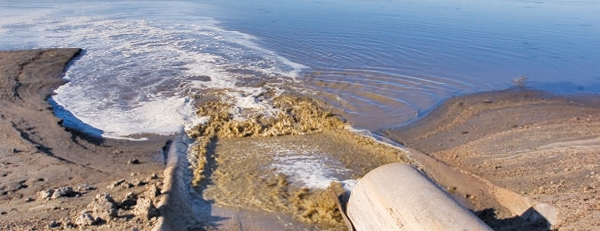Nothing beats summer heat better than diving into a pool or sipping a cold glass of lemonade. Luckily, like Hogwarts wizards, water engineers are working to ensure that water to beat the heat will be available, though the source might be unexpected. Increasingly, California's water will come from transforming the water we flush down our toilets, sinks, and washing machines into sparkling, pure water.
Indeed, potable water reuse seems like a no-brainer. So why don't we do it? In some places, we already do, and those places have lessons for the rest of the state and beyond.
Haizhou Liu, an associate professor of chemical and environmental engineering at UC Riverside has been collaborating with researchers at the Orange County Water District to find ways to seek and destroy more of the pesky pollutants that can squeak through even the most advanced purification systems, with support from the National Science Foundation.
The Orange County Water District operates the world's largest advanced water purification system for potable reuse. Highly cleaned wastewater that would ordinarily be pumped into the Pacific Ocean is instead put through a second purification process, after which it meets or exceeds state drinking water standards. In the 10 years since the reclamation facility has been in operation, more than 257 billion gallons of purified water has been produced to augment the region's local drinking water supply.
Instead of sending the purified water directly to customers' taps, a practice known as “direct” potable reuse, the recycled water is pumped to large ponds where it percolates through sand and gravel. It then rejoins groundwater, from which it will eventually again be drawn as drinking water, a process known as “indirect” potable reuse
To purify the water to drinking level standards, wastewater that has already had most of the organic contaminants removed passes through a microfiltration system to remove the finest particles. Next, the water squirts through a semipermeable membrane, a procedure known as reverse osmosis, which removes what mineral and organic compounds remain. But some tricky contaminants such as 1,4-dioxane, a potentially carcinogenic solvent used to make adhesives, dyes, textiles, and cosmetics, can occasionally squeeze through the membrane.
So in the final water purification step, the treated water is mixed with hydrogen peroxide and exposed to ultraviolet light, which liberates hydroxyl radicals to scrub the remaining pollutants. Researchers are working to improve this last step to make it more efficient and reduce the minute concentrations of contaminants—which are already below any level of health concern—even further.
In the ten years of operation of the Orange County Water District's advanced water purification facility, the concentration of 1,4-dioxane is routinely reduced to undetectable amounts after the ultraviolet and hydrogen peroxide advanced oxidation process. Because 1,4-dioxane is so stubborn, any above-ground engineered process that can remove it will also destroy almost anything else that survives the reclamation process. If 1,4-dioxane is removed, little else will also remain, making it a good proxy for measuring overall water purity.
This is where Liu comes in. Liu's lab is working with Dan Schlenk, professor of aquatic ecotoxicology, to examine unintended byproducts of oxidation and working with the Orange County Water District on ways to improve on the efficiency of 1,4-dioxane removal from the reverse osmosis permeate.
Like a tea strainer, the membrane used for reverse osmosis becomes clogged with the minerals, bacteria, viruses, and organic compounds it catches, so chloramines —chlorine substitutes derived from ammonia— are added by the water engineers as a disinfectant to keep it clean.
The added chloramines continue into the ultraviolet light treatment step, and Liu has found that under ultraviolet light the chloramines break down into chlorine radicals that act as oxidants to break down 1,4-dioxane. However, the chloramines can also consume some of the hydroxl radicals critical to the success of the ultraviolet treatment process, weakening its effectiveness.
When Liu's lab tested a different oxidant known as persulfate, it broke down into sulfate radicals that work synergistically with the chlorides to remove more 1,4-dioxane than hydrogen peroxide. Moreover, the sulfate radical is pickier about what it attacks. Because it doesn't waste energy destroying harmless compounds, it removes the bad chemicals more efficiently than the hydroxyl radical.
Unfortunately, the 1,4-dioxane does not just vanish or morph into something entirely benign. The researchers also discovered that oxidation by either hydrogen peroxide, persulfate, or chloramines changes changes 1,4-dioxane into glycolaldehyde and formaldehyde, both of which damage DNA and can lead to birth defects and cancer. To the researchers' relief, the oxidation reactions continue to degrade the aldehydes until they, too, disappear.
One could argue all of this is a moot point if people aren't willing to drink recycled water. A study led by UC Riverside psychology graduate student Daniel Harmon found disgust at the thought of drinking water that had once been in a sewer a powerful factor against direct potable water reuse, even when people could not taste the difference.
But water scarcity is a fact of life in California, as in many other parts of the world, and direct potable reuse will probably be coming soon to a faucet near you. “We are facing increasing water stress throughout the southwest U.S. and other parts of the world. Development of an efficient oxidation treatment for water reuse will be very important to sustain a reliable water supply for years to come,” Liu said.
